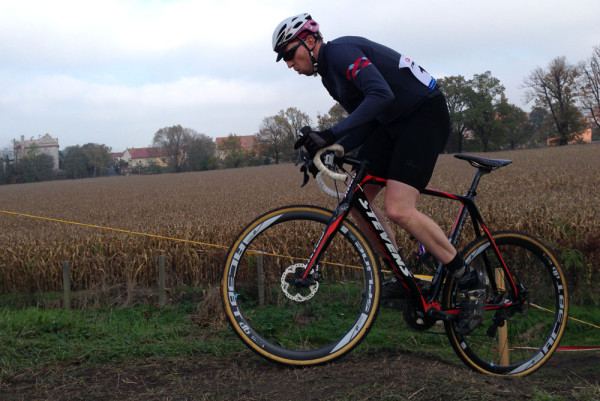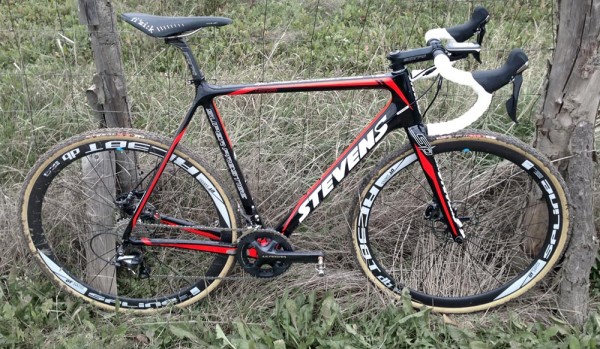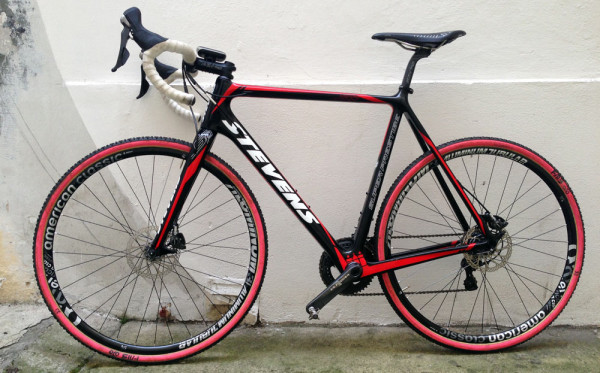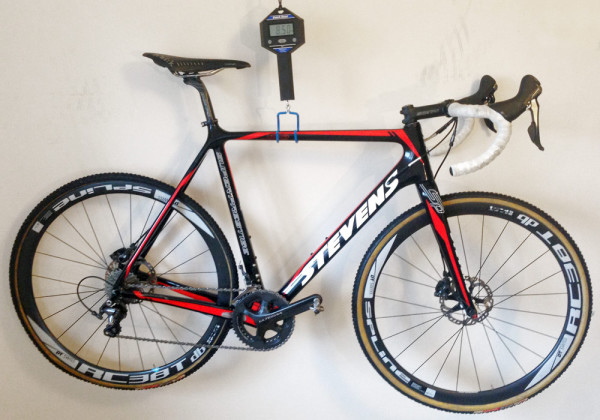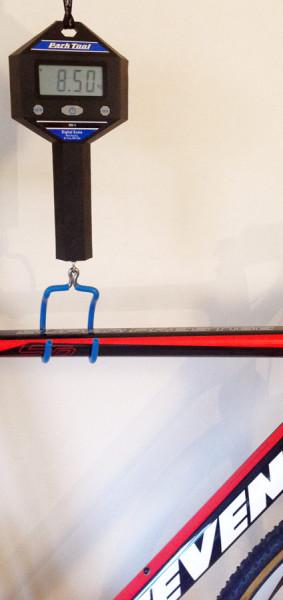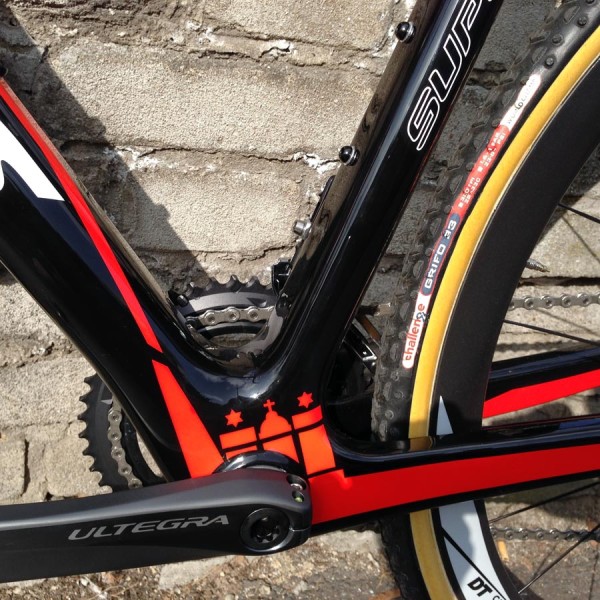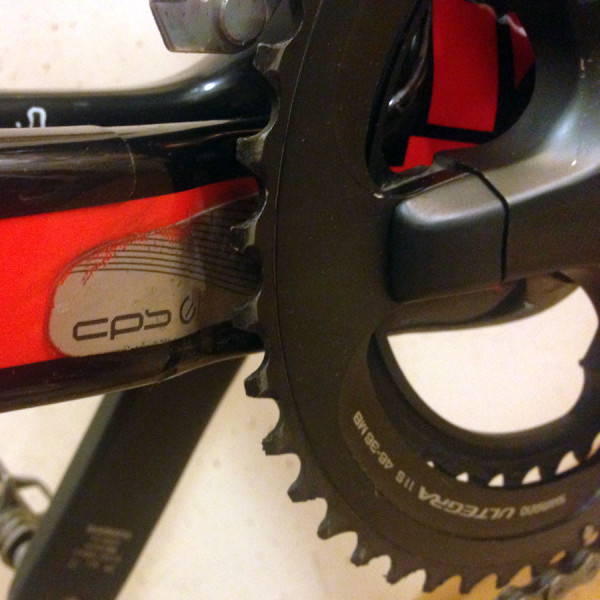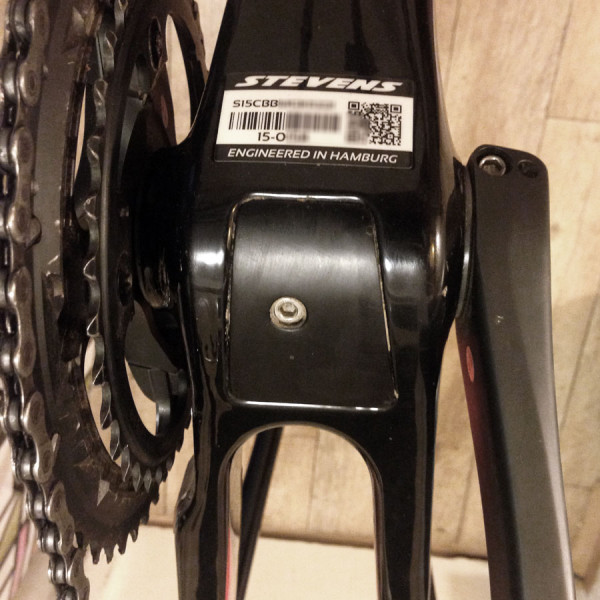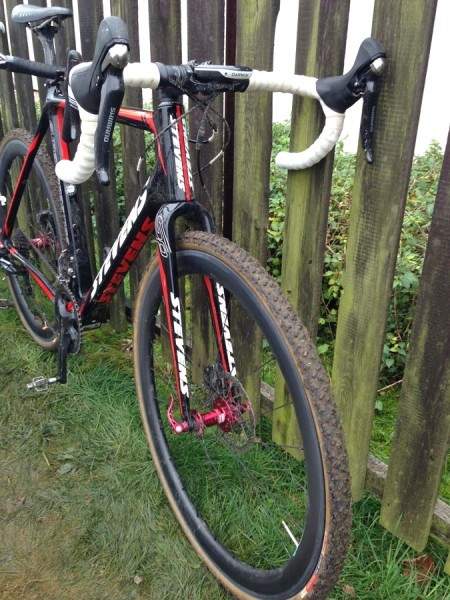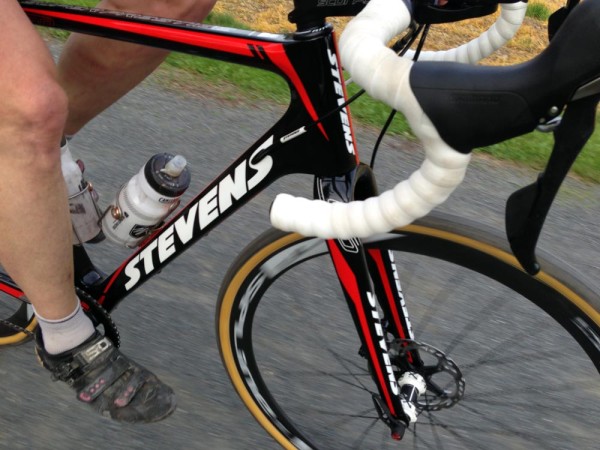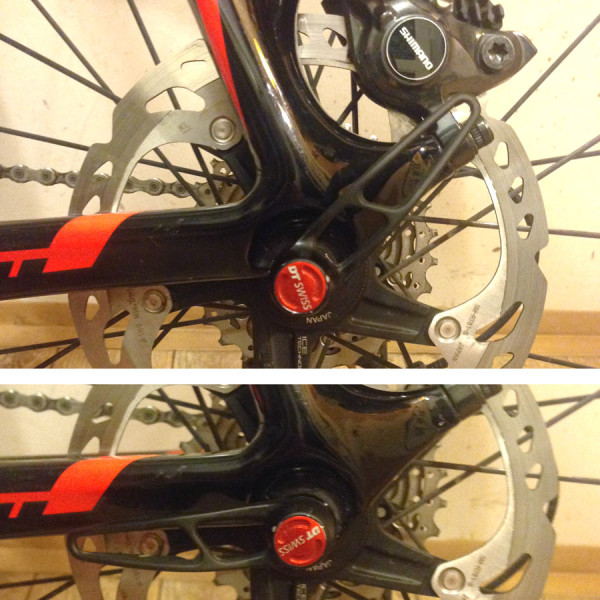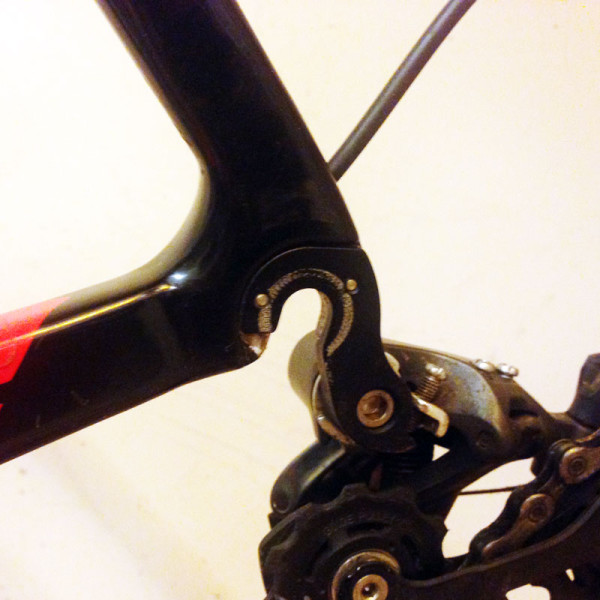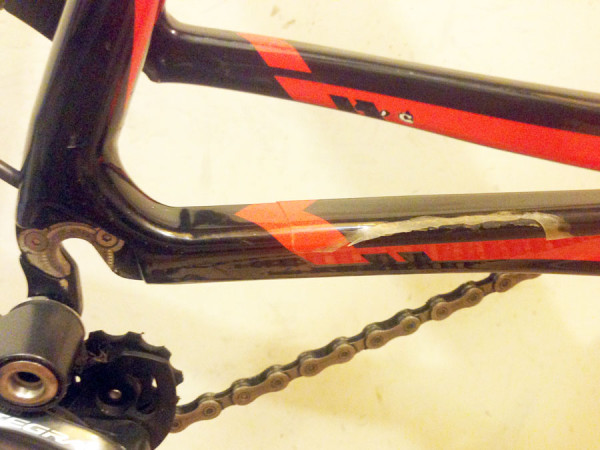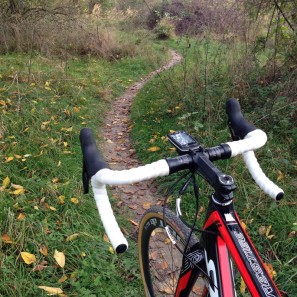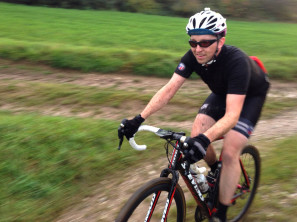As we lead into the upcoming UCI Cyclocross World Championships this coming weekend here in the Czech Republic we want to give a complete rundown on one of the bikes we’ve been race testing all season as a part of our EU CX test series, that will see some elite-level international racing under some of the world’s best athletes. The updated 2015 Stevens Super Prestige Disc, which we introduced back at Eurobike, is billed as an all-out race bike so we’ve been doing our best to shake it out in our national series of Masters cross races, coincidentally co-sponsored by Stevens Bikes along with Czech clothing producer Lawi. Besides our amateur level racing and their support of grassroots racing programs throughout Europe, the Super Prestige has recently been ridden to a lot of great results under professional racers.
At the start of 2015 Stevens expanded their pro team sponsorships to include the Stevens Racing Team, Corendon-KwadrO, and now cyclocross powerhouse BKCP-Powerplus. With the new team sponsorships in place for all of the 2015 national championship races a couple of weeks back, riders on the Super Prestige and Super Prestige Disc took home 7 national titles including: German women’s elite, German men’s junior, German men’s elite, Belgian men’s U23, Swiss men’s elite, Czech men’s elite, and Dutch men’s elite. Clearly the bike can handle the top level of racing, and we look forward to seeing if one of these Stevens-sponsored riders will stand on the top step of the podiums at Worlds in Tábor. Until then, join us after the jump for our full breakdown on how the bike performed under us, both on and off the cross course.
Weights & Specs
The bike that Stevens gave us on loan for our extended test was a large sized 56cm Super Prestige Disc outfit to race out of the box. While a 56 isn’t typically that big of a bike, here it measures from the center of bottom bracket to the center of the toptube, and with only very mildly-sloping geometry gives proper clearance in the main triangle for easy shouldering.
The cross bike arrived a bit before the start of our race season, so we had a chance to get some gravel road and singletrack training kilometers on it before seeing any course tape. It also was our first real long-term hands-on experience with the newly released Shimano RS685 Hydraulic disc-brake/Mechanical shifters, which made it onto my holiday wish list after riding this bike. They were part of an otherwise complete Shimano Ultegra 11 speed groupset, with Shimano 46/36 cyclocross-specific gearing. Contact points were size-specific from house brand Oxygen, with an aluminum bar and stem, plus a lightly padded ti-railed saddle. The saddle was a bit short and too shapely for my personal fit, so a standard k:ium Fizik Arione was swapped in for the majority of the test.
The wheelset was one place where the bike stood out as a true race bike, coming stock with carbon tubulars from DT Swiss. The new for 2015 DT Swiss RC38 Spline T DB are heavy on acronyms but light overall at about 1350g. The 38mm mid-depth carbon rims have 24 bladed spokes laced 2x both front and rear, and internal spoke nipples. The hubs are essentially straight-pull DT 240s and can be adapted for thru-axles. The Stevens uses standard quick release sizes, but included DTs RWS spin-to-tighten QRs.
Wheels are one of the highlights of the way Stevens sells their top end bikes. Most of their race bikes are equipped with a semi-custom wheel program. Very often this means you get the standard bike build, but get to pick which wheelset to include while still getting standard non-custom pricing. Options generally include at least an aluminum clincher option, a carbon clincher option, and a carbon tubular option. This really is nice as you can splurge on better race wheels if you can afford it, without having to upgrade a bike right out of the box.
The bike came with Shimano 160mm Ice tech centerlock rotors on the DT Swiss hubs. Both the Stevens 1.5″ tapered all-carbon fork with its forward facing dropouts, and the frame with post mounts on the seatstay, are only 160mm rotor compatible. So unfortunately you couldn’t size down to 140s even with Shimano’s centerlock-only Freeza rotors. The wheels with their graphics under the clear coat, also curiously state the maximum tire size at just 27mm. A bit strange since the DT Spline wheels are being spec’d on many disc-brake cyclocross bikes, and ours arrived with Challenge’s popular 33mm Grifo tubulars glued on.
Besides the DT wheels provided we also swapped in a set of American Classic aluminum tubular disc-brake wheels shod in french handmade FMB Slalom tubulars and a set of Novatec carbon clinchers with Limus mud and assorted road tires during training, all of which we also have in on test. This let us try to isolate the ride character of the frameset and wheels, as well as the impact that deeper carbon wheels have both for cyclocross in the mud or out on windy roads training.
Our 56cm bike with DT tubulars weighed 8.5kg, complete with a pair of 280g eggbeater pedals (courtesy of our friends at Progress Cycle and Crank Brothers). While not an exceptionally low weight, for a large cyclocross bike complete with pedals it is reasonable and is achieved with a lot of room to shed grams in the cockpit if you wanted. And we appreciate that the large bike is only 100g over the weight Stevens claims on their website. In the end it always felt light when it wasn’t caked in mud.
The complete bike (without pedals) retails for €3700 as we tested it with mechanical/hydraulic Ultegra and the 38mm deep DT tubulars. It will drop down to €2700 with an aluminum clincher wheelset, and is also available as a frameset for €1700.
Product Details & Tech
The bike we’ve tested was set up with mechanical shifting, but the modular ports on the frame make sure it is Di2 ready with an internal seatpost battery. They also allow for complete internal routing of the hydraulic lines, and we didn’t notice any rattling of cables/hoses inside the frame.
The high modulus carbon fiber Super Prestige has a lot of features that add up to a very aggressive race-type ride, and a few that maybe detract from the overall versatility of the bike. Probably the biggest element that has this crossover effect is the combination of a large, wide press fit Shimano bottom bracket connected to large diameter rectangular chainstays and an oversized downtube. Together they make for incredibly stiff power transfer to the rear wheel (and a nice place to put a graphic of the towers of Stevens’ hometown of Hamburg), but at the expense of long ride comfort in the saddle. The rest of the frame uses pretty standard tubing shapes and sizes, but they can only do so much to quell the stiffness that makes the bike jump off the start line.
Around our 65mm drop bottom bracket, a couple of other small details stand out to increase usability. A molded in stainless anti-suck chainstay protector protects the big oversized driveside chainstay, although with the nicely tuned Ultegra group and smaller 46/36 cross rings, we never experienced chainsuck, even in muddy races. The wide bottom bracket junction also allows a smooth bridgeless chainstay configuration that never packed up with mud. Although the traditionally routed front derailleur means that there is a shift wire that pokes out of where a bridge would normally be, and does build up with grass in wet conditions. Maybe a bigger concern was really the front derailleur; with Shimano’s new high leverage 11sp front derailleurs, the long arm really collects a lot more mud and grass than the previous generation, packing up around the clamp and seat tube. Lastly under the bottom bracket, a removable cover plate gives access to the internal cable routing, and where you can also find a QR code making serial number tracking easy. We were a bit worried about mud and water getting in at the plate, but after many wet rides and muddy races and several times pressure washing the bike, we never had an issue. In the end we even got the impression that water coming in at the gear cable for the front derailleur seemed to have drained itself out around this plate.
Tire and mud clearance was respectable both in the fork and frame. Being a elite race bike, it will most likely only see 33mm tires like what we spent most of our test on, but we had ample clearance when we tried a set of 38s. It is a bit tighter in the frame than fork, but we never had mud pack up to the point where it dragged the tires like we have on other bikes. One nice add-on for a cross bike is the inclusion of 2 bottle cages. While it is pretty common in order to allow training outside of the race environment, we do still run into a few bikes without bosses on the cyclocross circuit, which does limit versatility.
A few details at the rear end gave us pause, but ended up as only minor annoyances. I always liked the idea of the DT Swiss RWS QR, as something between a thru-axle and quick release that should allow extra clamping power. But with the very large tubing shapes of the Stevens disc dropout, the available movement of the RWS QR was severely limited. Only being able to lever from about 2 o’clock to 9 o’clock meant a lot of going back and forth whenever the wheel was put in or out. And even at just 2-9, I was fighting to get my fingers around the lever to pull it out to freely spin it back for the next movement, of which you had to struggle to do at least 3 or 4 times. While I’ve experienced a similar issue on some sliding dropout frames, it is usually only one position that is limited. Here it was a big enough deal that if the bike was mine, the rear RWS would find itself in a spare parts bin very quickly.
The fact that the bike appears to be only compatible with 160mm rotors seem a shame for a true race bike. Apart from long road descents we don’t see the need for 160mm rotors on a cyclocross bike, especially with Shimano’s Ice tech and Freeza technologies to keep them cool. Certainly, in our time riding and racing the Super Presitge off road, we would have almost always preferred the little less bite that a smaller set of rotors would give. We are also interested to see what develops, because unless our eyes are mistaken, the custom camo Super Prestige Disc that Mathieu van der Poel has ridden to several wins since the start of the year is equipped with 140mm Shimano Freeza rotors.
Also looking at the dropouts, it was a bit strange to see how the replaceable hanger didn’t really fill out the slot in the dropout, and seemed like a few more millimeters of aluminum would give that difficult-to-operate skewer a bit more material to dig into. In our test, we had no issues with it, and the extra bite it could provide is truly minimal, but it stood out in our minds. On the other side of the driveside chainstay we also ran into a little issue with the rubbery chainstay protector. Again a totally minor concern, but a bit of heel rub began to pull it off from the start, and due to its sticky nature we weren’t successful in either trimming the damaged area or removing the thing altogether.
Ride Impressions & Review
While there were a few little nits to pick, I want to be careful to not get away from how quick the bike felt to ride hard.
From a racing perspective, the stiffness of the frame truly led to amazing power transfer. Coming off of mostly racing with high-end steel cross bikes for the past couple years, pedaling the Super Prestige felt like a rocket on the starts. Every race I started on this bike had me get to the first section of technical trail or turns between 5-8 places sooner than I did on any steel bikes (this season or last.) Racing another top-end carbon bike this season also felt like it was faster off the line, but nothing compared to the repeatable sprinting performance of the Stevens. That meant I spent less time fighting through traffic of less technically skilled racers, while giving me a few more wheels to suck before settling into my real position in the races. The stiff platform also performed well railing everything from hardpack to sand to muddy turns. And with tubular tire pressures down in the mid 20s the bike didn’t seem to bounce around on roots and ruts any more than other bikes did, keeping traction even in the rough stuff.
That being said, from a multi-use perspective the bike would be less than optimal. The overall stiffness of the rear-end of the bike really took a toll on my back after long off-road rides over a couple of hours, while 45-60 minutes of intense racing never was an issue. This 2015 update of the bike got rid of the previous generation’s integrated seat mast which was surely a good move, but without a lot of the 27.2mm seatpost exposed, a more forgiving post would still help a lot to damp some of that rigidity before in makes it to the rider. The fork on the other hand was quick handling and responsive, but never felt like it was beating you up. And the house brand stem and bar provided good stiffness, while also not feeling harsh.
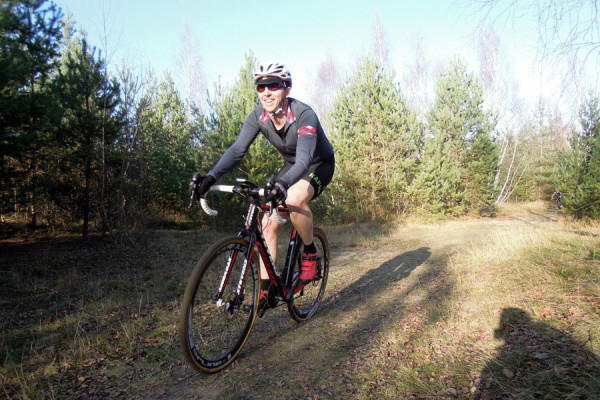
More of a note really due to the bike’s race focus, the carbon tubular wheelset also meant the bike was not really intended for unsupported training rides, not that it really stopped us in our tests without any issue. I did cut a hole in one of the Grifo tubulars on a piece of metal while preriding a cross course ahead of a weekend’s racing, and had to break out a needle, thread, and glue to get it back in working condition a couple of weeks later. Not only did I have to ride a kilometer or so to get back to where I could catch a ride and swap out for another wheel, but the flat tubular sitting off to the side on the rim by about a centimeter was enough to rub on the chainstay and quickly scuff the clear coat on the inside of the on the chainstay. The bike would definitely be more versatile with a clincher wheelset (and DT makes the same Spline 38 wheelset in a clincher version), but it would also be a detriment to its race character, which would be a bit of a shame.
The Super Prestige Disc really wants several wheelsets. That’s kind of a perpetual problem of a cyclocross race bike. You really want at least two tubular wheelsets with conditions-specific tires, plus a clincher wheelset for training. Then that kind of negates the benefit of Stevens’s semi-custom wheel program, and certainly won’t be easy on the wallet.
All that said, we are sad to see the bike head back to Hamburg, just like we are sad to see the last cyclocross races of the season tick away. Now we’ll get back to exploring more forest roads and putting a bit of distance in on the road, but when we ride past a cross course or even a muddy field we’ll think back to those fast starts.
And we’ll see if we can pop our head in at the upcoming World Championships to see if any of the Stevens-sponsored racers end up on the top step or if any of the team mechanics have some interesting ideas to share.
